
Knowing how to build trust with customers is one of the most important steps you can take to grow your business. 58% of U.S. customers indicate that a company’s reputation is a top consideration when investing in a product or service. This shows just how much impact trust can have on your bottom line.
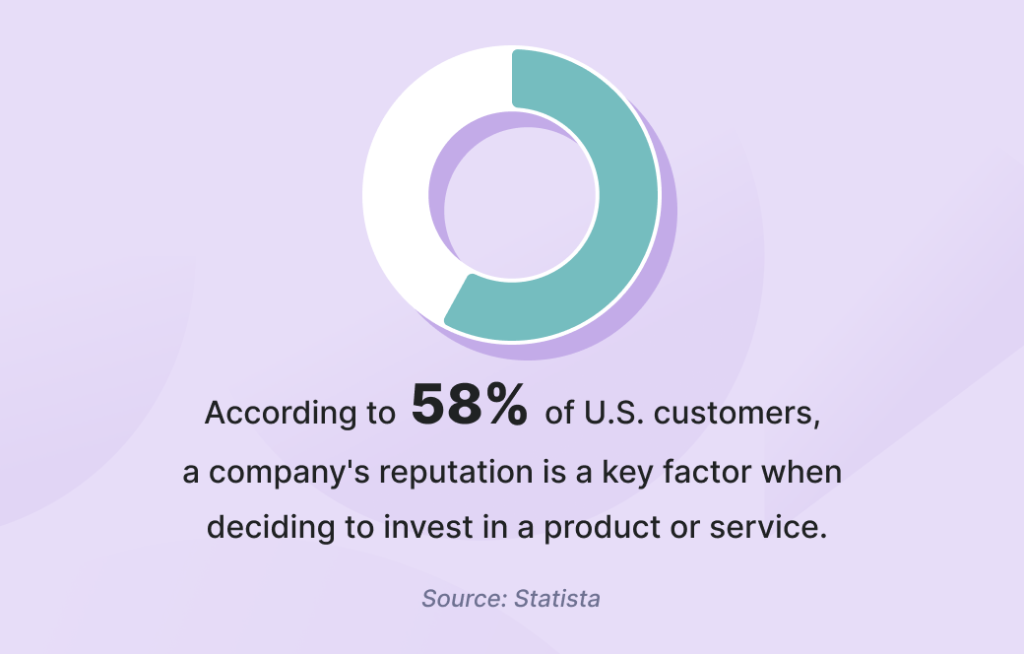
A strong, positive reputation helps you attract new customers and retain existing ones. But it doesn’t stop there. You must continuously prove your reliability through transparent communication, consistent service, and responsiveness to feedback.
Let’s see how to build trust with customers from the start, maintain it over time, and even repair it if it’s been damaged. With these practical tips, you’ll be able to create stronger, more enduring relationships with your customers.
Why is it important to build trust with customers?
The core of long-term success in any business is trust. When customers trust your brand, they’re more likely to return for future purchases, increasing their lifetime value. Trust also reduces customer churn, as clients are more likely to stick with brands they believe in.
Another major benefit of customer trust is its role in generating referrals. Customers who trust your brand become your most powerful advocates, encouraging others to try your product or services.
Building trust also means minimizing risk in the customer’s eyes. When customers know that you’ll deliver quality consistently, they are more likely to stick with your brand over time.
Loyalty vs trust
Loyalty is often driven by familiarity or customer satisfaction with your products or services.
Trust reflects a customer’s belief in your reliability, honesty, and commitment to delivering value. When trust is present, customers feel more confident in recommending your brand to others, turning loyalty into active advocacy.
🤝 A customer may stay loyal to your business for convenience but switch to a competitor if something goes wrong. However, trust is the foundation that makes loyalty sustainable, building deeper connections and resilience in the relationship.
How to build trust with customers the right way
Focus on being open, consistent, and reliable to build customer trust. Here are some strategies that we use to build trust with our clients.
Communicate transparently
Open, honest communication is critical in business-to-business (B2B) relationships. When you’re transparent, clients feel informed and valued, leading to stronger, more reliable partnerships.
- Be clear about your product or service capabilities and limitations, so there are no surprises.
- If any issues arise, communicate them early. Clients appreciate proactive service rather than last-minute fixes.
- Share updates on your company policies and pricing openly, especially when adjustments are made.
- Encourage regular customer feedback and take immediate steps to address concerns, showing that their input matters.
OpenAI sets a strong example of transparent communication by being upfront about GPT-4’s limitations. Sharing its strengths, weaknesses, and evaluation data allows users to approach the technology with clear expectations.
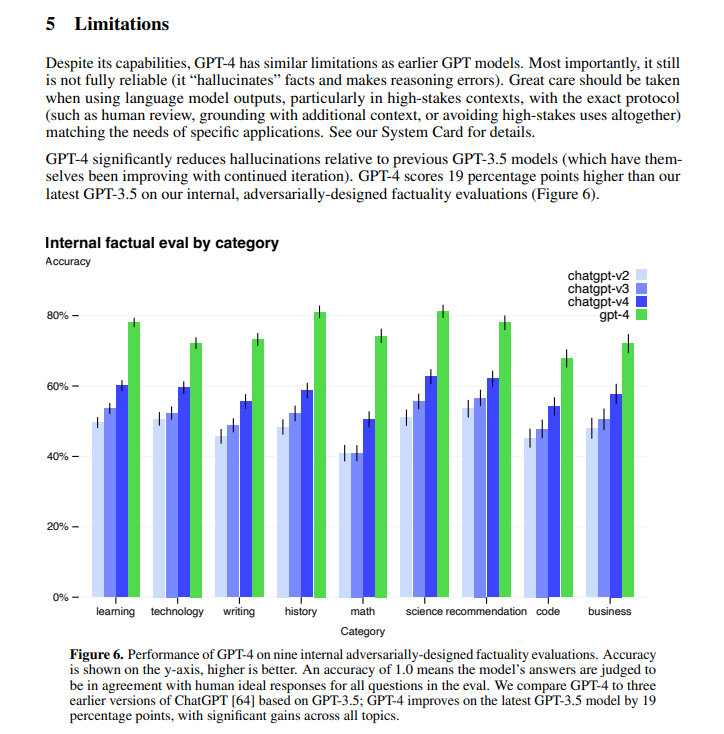
Image source: openai.com
Deliver consistent value
Consistently offering value establishes trust and credibility with customers, creating a sense of reliability. As they come to expect reliable service from you, their confidence in your brand increases.
- Establish clear processes to ensure that quality is maintained uniformly at every touchpoint.
- Set clear expectations through service level agreements (SLAs) and stick to them.
- Focus on continuous call center training to maintain a high-performing team capable of handling evolving customer needs.
- Monitor performance metrics and customer satisfaction scores to track consistency over time.
Underpromise and overdeliver
Overpromising can backfire, leading to disappointment and damaged trust. Instead, focus on underpromising and overdelivering to surprise customers with positive outcomes.
- Clearly explain what customers can expect from your product or service, avoiding vague promises.
- Keep your customers updated as each milestone is met, demonstrating progress ahead of schedule.
- Commit to deadlines you can realistically meet and aim to deliver earlier than promised.
- To avoid customer frustration, be transparent about potential delays or limitations before they become issues.
Provide excellent customer support
In 2024, 88% of customers saw customer service as more essential than ever, a rise from 83% in the prior years. Your customers want to feel heard and understood, especially when they’re facing issues or frustrations.
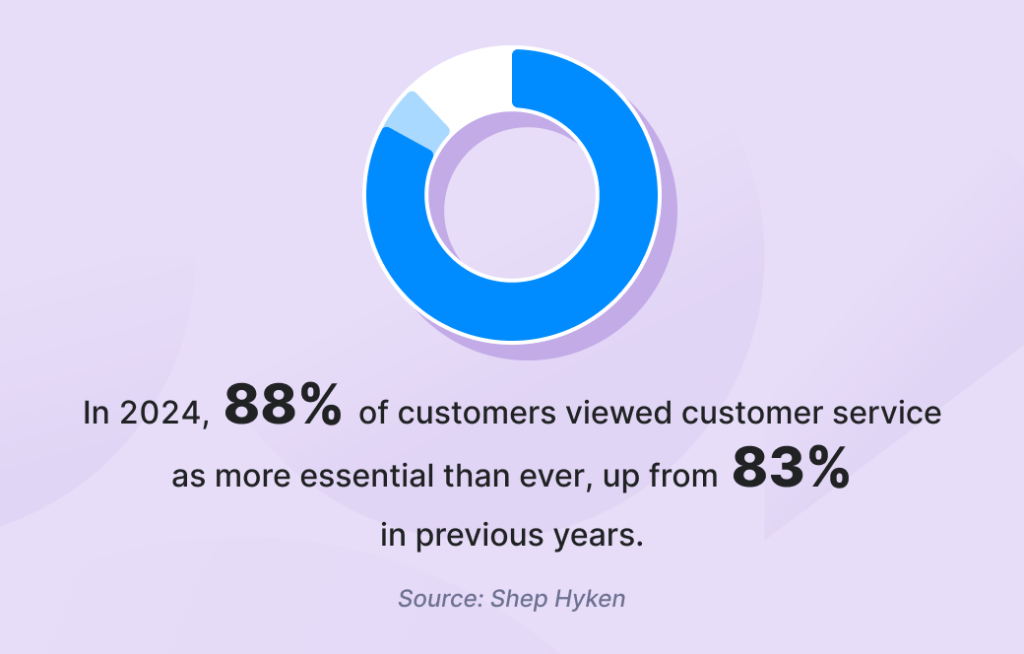
- Respond quickly to all inquiries. Customers value timely support, and quick replies show you prioritize their needs.
- When handling complaints or issues, show empathy. Acknowledge their frustration and validate their feelings.
- Use consistent and professional language. Providing your team with ready-to-use email templates ensures all email customer communication meets the same high standard.
- Provide clear access to support. Whether through live chat, email, or phone, customers should easily reach someone who can assist them.
- Use contact center automation for routine tasks like tracking orders or answering basic questions. However, when the issues are more complex, make sure customers can easily connect with a human agent.
Frank Sondors, founder at Salesforge, reinforces this idea:
“At our company, we’ve found that offering real-time support during critical moments, such as onboarding or resolving technical issues, has been an integral factor of our strategy. This sees to it that customers feel valued and supported right when they need it most, which naturally builds confidence in your brand.
When you address concerns immediately, it often prevents small issues from snowballing into larger frustrations, creating a smoother experience overall. For example, implementing live chat during onboarding cut our response time by 42.6%, which improved customer satisfaction scores by 25% over six months.”
Humanize your brand
When you humanize your brand, you give it a personality people can connect with. It’s about moving away from just selling a product or service to sharing the real stories, values, and people that make your brand what it is.
- Show the people behind your business. Introduce your team through photos, videos, or social media posts.
- Regularly release resources that address common pain points or needs in your industry.
- Feature real customer testimonials that reflect how your product or service has impacted them.
- Stay consistent with your content. Whether it’s weekly blog posts or monthly newsletters, keep your audience engaged.
Stripe shares stories from real businesses using authentic, relatable examples. These examples highlight specific results, like faster payments or easier global expansion, that businesses achieved through Stripe. This strategy reassures potential customers that Stripe is a dependable partner.

Image source: stripe.com
Embrace customer feedback
Trust is built when customers feel their feedback matters. Listening and responding appropriately can deepen the relationship.
- Use emails, social media, in-app surveys, or live chat to gather customer opinions.
- Acknowledge feedback as soon as possible, even if you don’t have an immediate solution. For example, thank them for their input, let them know you’re looking into the issue, and provide a timeline for updates if needed.
- When you make changes based on feedback, communicate those updates through emails, blog posts, or social media.
- Show appreciation to customers who provide actionable suggestions by offering discounts, exclusive access, or simple thank-you notes.
Recognizing the need for flexible, spontaneous collaboration, Slack introduced Huddles in 2021. It quickly became the platform’s fastest-adopted feature, achieving a 95% customer satisfaction rate.
When users later asked for more music options, Slack responded with the Huddles Jukebox, offering a variety of new tunes. Acting on customer feedback and keeping them informed helped Slack further strengthen trust in its brand.

Image source: wired.com
Prioritize data privacy and security
Your customers expect their personal information to be kept safe. Personal data protection is one of the top concerns for 83% of clients when it comes to trusting a company.
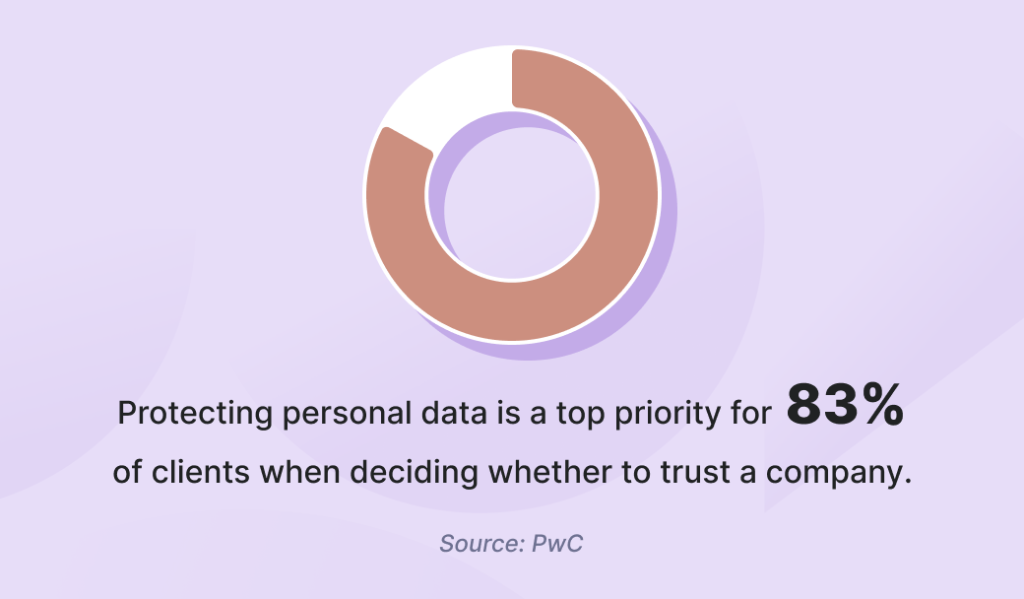
- Keep your security systems up to date and communicate any changes to your customers.
- To demonstrate your commitment to privacy compliance, follow laws like GDPR, CCPA, or any local regulations that apply.
- Conduct regular audits of your data protection systems and share the results with customers.
- Give customers a clear and simple way to unsubscribe from email marketing campaigns.
- If customers no longer wish to use your services, they should be able to request the deletion of their data. So, offer a simple “delete account” option in their account settings or through customer support.
Four tips for building trust online
If you’re looking to understand how to build trust with customers online, it all starts with clear communication and genuine engagement. The following four strategies will help you create a trustworthy online presence that keeps customers coming back.
1. Design a trustworthy website
Your website is one of the first things people notice about your brand. Make sure it gives off a good impression.
- Keep the design simple and clear: A neat layout with easy navigation makes it user-friendly.
- Be upfront about your policies: Share clear details about your privacy policy and terms of service.
- Provide contact options: Add a contact form so visitors can message you easily. Include FAQ pages to answer common questions.
2. Be authentic on social media
To gain trust on social media, authenticity is key. Don’t just post promotional content — be transparent and engage in real conversations.
Here’s how you can make your brand feel more relatable online.
- Engage in conversations: Respond to messages and comments with thoughtful answers, not just automated replies.
- Respond to feedback: Don’t shy away from negative comments. Address them openly, offering solutions and showing you care about fixing any issues.
- Use user-generated content: Showcase your customers’ experiences and stories. When your clients become your advocates, it strengthens your credibility and trustworthiness.
3. Highlight certifications and trust signals
As previously mentioned, customers are more likely to trust your brand when they see proof of your security and reliability. Adding these elements shows you take their confidence seriously.
Consider the following practical ways to use trust signals.
- Highlight secure transactions: Include badges for secure sockets layer (SSL) encryption and payment security on your website.
- Display recognitions: Feature any certifications or awards that demonstrate your credibility.
- Mention trusted affiliations: Show partnerships or connections with reputable brands or organizations. Gaining trust is easier when your customers can see clear evidence of your reputation.
Parker Gilbert, CEO at Numeric, backs this up:
“As far as building trust online goes, social proof is the gold standard. If you have customers who can give you G2 reviews or reviews on other third-party platforms, that’s always ideal.
We’ve also seen really good signals just from being super consistent with our LinkedIn presence. Not only do people find out about our product from there, but we’ve had people say that we seem “big” because we have a dedicated LinkedIn presence.”
4. Create valuable, consistent content
Learning how to build trust with customers online involves offering content that is useful and relevant to them. Here’s how to approach this correctly.
- Publish regular blog articles and guides: Share helpful content that answers common customer questions or addresses industry challenges.
- Share downloadable guides and tools: Craft valuable resources like whitepapers, e-books, and case studies that explore relevant topics in depth. Give your audience free tools or templates to help them take action.
- Position your brand as a thought leader: Use your content to highlight your industry knowledge. Share insights on trends, best practices, and innovative solutions to establish your brand as an authority.
Jessica Andrews, VP of marketing at Copper, shared how to fully leverage the power of content:
“One way we encourage our clients to build trust with their customers is to proactively share useful content. We recommend setting up a Google Alert for their customer’s industry keywords and being ready to send them news articles, podcasts, or other content that’s relevant to them. When you talk about subjects beyond the product or service you’re selling, it helps build a personal relationship.”
How to earn trust back after it’s lost
When you openly admit your mistakes, you show customers that you are responsible and willing to improve. Rebuilding trust starts with the following key actions:
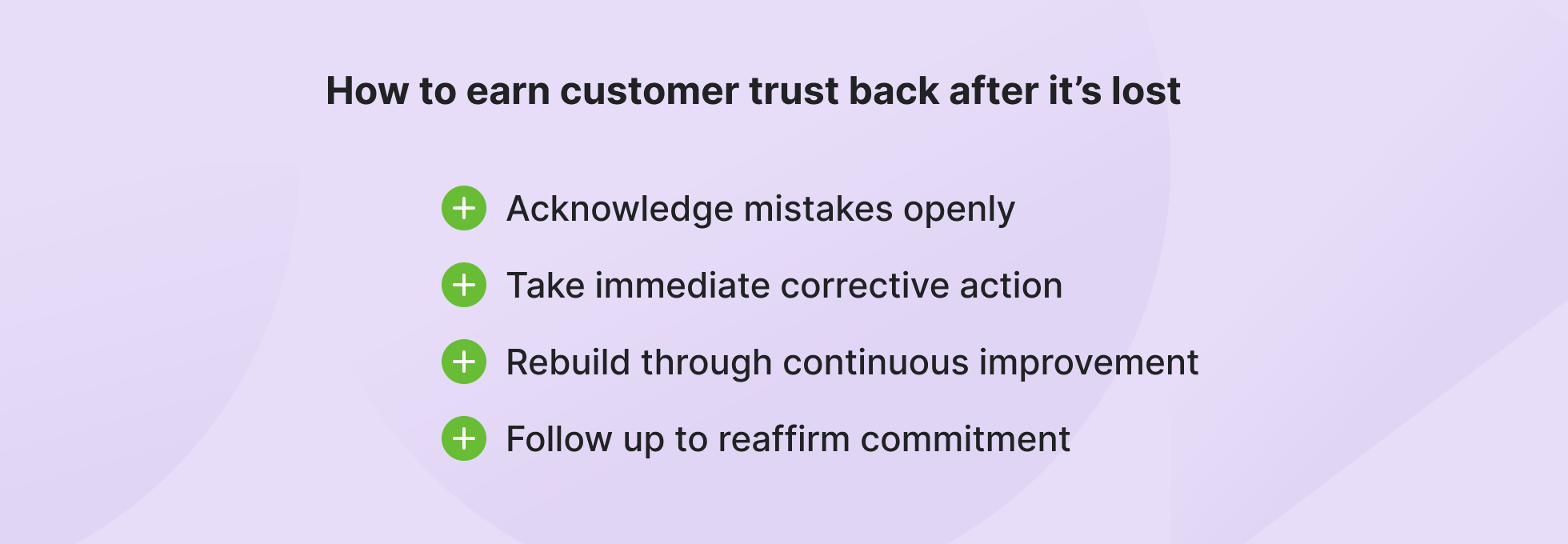
Acknowledge mistakes openly
If you’re wondering how to gain trust back, admitting your mistakes is a good place to start. Here’s why it matters.
- It shows you’re being real: Admitting a mistake proves you’re not hiding anything. Customers appreciate honesty and see that you’re not trying to dodge responsibility.
- It makes your relationships stronger: Apologizing and taking responsibility shows you care about your customers.
- It earns respect: People respect brands that are willing to be honest and admit when things go wrong.
After hackers attacked Okta, the company initially downplayed the situation, stating the breach impacted just 1% of its customers. However, it later emerged that the breach was larger, with the entire support system’s database compromised. Sensitive data, including the names and emails of high-profile clients like Zoom, FedEx, and Peloton, was stolen.
Okta informed its users about the extent of the breach via an official letter. It openly acknowledged the full scope of the attack, including the theft of information from high-profile clients. Rather than downplaying the situation further, Okta made it clear that it was taking immediate corrective actions to secure its systems and prevent similar incidents.
Take immediate corrective action
Speaking of corrective actions, once you’ve admitted your mistake, it’s time to act fast and show you’re committed to fixing it. Focus on making visible changes with these actions.
- Act quickly: Begin addressing the problem right away.
- Offer compensation or alternatives: If your customers were impacted, offer refunds, replacements, or other ways to make it right.
- Make long-term changes: Implement lasting changes to prevent similar issues from happening in the future, showing customers this won’t repeat.
Rebuild through continuous improvement
Indeed, mistakes can be a chance to improve and regain trust. Use them as an opportunity to identify what went wrong, improve your processes, and prevent the issue from happening again. Take these actions to rebuild customer trust.
- Analyze the issue: Identify what went wrong and why. Use that understanding to address weak points and create better systems or processes.
- Share your progress: Keep customers informed about the changes you’re making. Explain how these changes address the problem and prevent it from happening again.
Follow up to reaffirm commitment
Rebuilding trust with clients includes providing continuous updates on your improvement actions. These are two strategies for successful follow-ups.
- Keep customers in the loop after a trust breach: Following up shows that you’re serious about maintaining a strong relationship.
- Proactively prevent future mistakes: Don’t wait for another issue to arise. Show your customers that you’re actively working on preventing further issues from happening.
How do you build trust with your customers?
Knowing how to build trust with customers is an ongoing process that requires consistent action. Trust forms the foundation of strong, long-term relationships, and it takes time to earn and maintain.
Each interaction with your customers is an opportunity to reinforce or erode that trust. Consistently being transparent, reliable, and responsive helps build a solid foundation that secures loyalty and drives growth.
Now that you’ve learned the steps for building trust with customers, it’s time to assess your current approach. Are you delivering on promises? Are you communicating openly with customers?
Use the tips we provided to improve your approach, address any weaknesses, and strengthen connections. Always remember the words of Ernesto Pramasetya, co-founder at GiantFocal:
“Trust is like a bank account — you need to make regular deposits through consistent positive interactions before you can afford to make any withdrawals.”
Frequently Asked Questions (FAQs)
Be transparent, deliver on promises, respond quickly to questions, and consistently provide value. Trust is built through actions, especially when issues arise and are handled with honesty and care.
Communicate regularly, personalize your interactions, listen to feedback, and show appreciation. Strong relationships grow when customers feel seen, heard, and supported over time.
Educational content like how-to guides, product walkthroughs, customer success stories, and FAQs help build credibility. Transparent messaging and consistent support content also reinforce trust.
The four keys are competence, consistency, transparency, and empathy. Being reliable, honest, and understanding can be a game changer in any industry.
Loyalty develops when customers have consistently positive experiences, feel valued, and believe your brand delivers real, lasting value. Rewards programs, personalized offers, and responsive service all contribute.
Related articles
When was texting invented: A history over 30 years in the making
From the early days of mobile communication to the b...
How to promote a new product launch with SMS marketing
Launching a new product is exciting for any business...
54 Ready-to-use text message templates for businesses
Crafting the perfect message that will resonate with...
PRI vs. SIP Trunking: What is the difference and which one to use?
At their core, both PRI and SIP trunking are designe...
Fitness center and gym SMS solutions + 15 free text templates
Every New Year, fitness clubs see a HUGE increase in...



